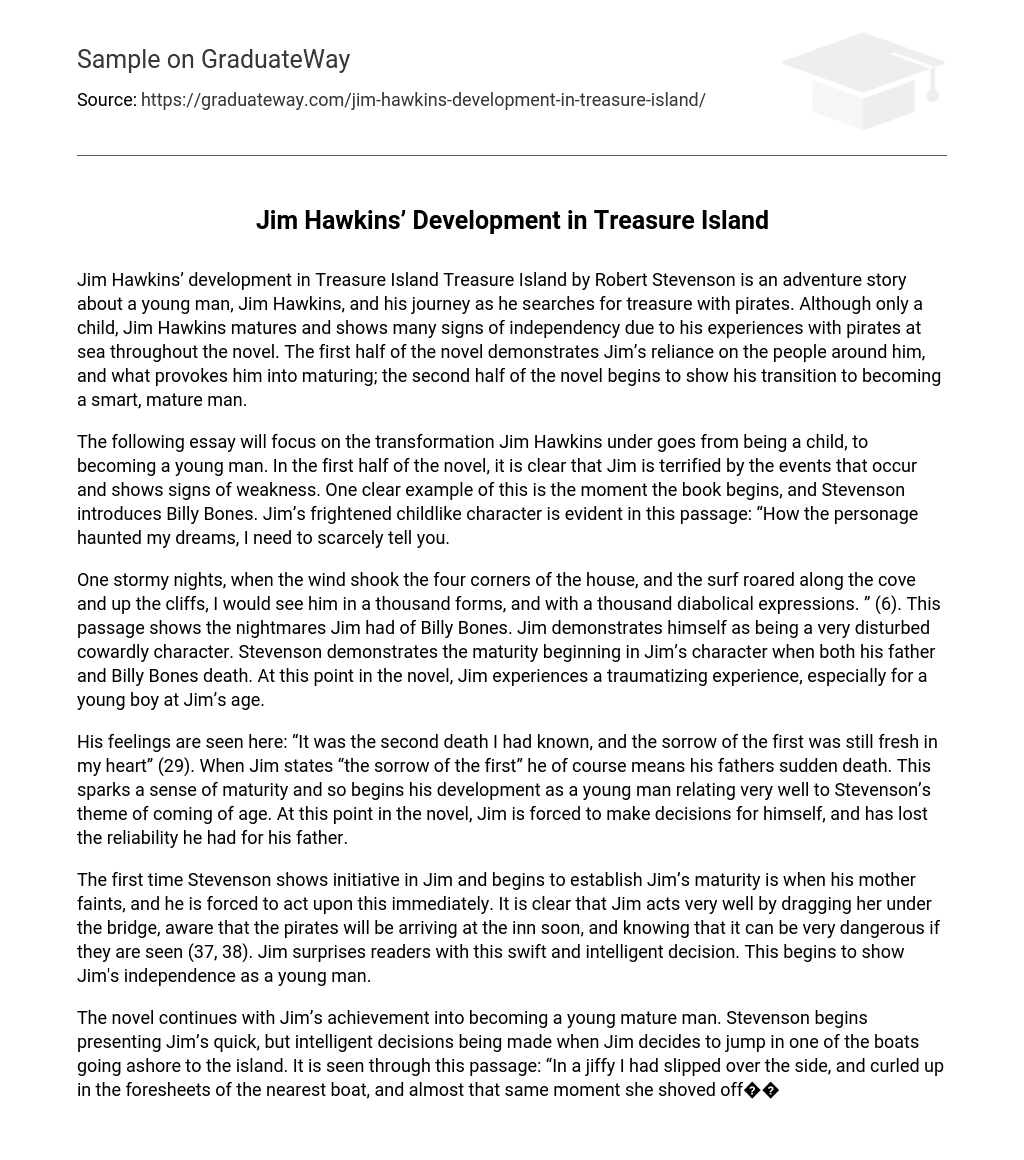In Treasure Island by Robert Stevenson, Jim Hawkins embarks on an adventure to find treasure with pirates. Despite his young age, Jim undergoes personal growth and becomes independent as his encounters with pirates shape him throughout the story. The first half of the novel depicts Jim’s dependence on others and the events that prompt his maturity. The second half of the novel illustrates his transformation into a clever, mature individual.
The essay will focus on the transformation of Jim Hawkins from a child to a young man. In the first half of the novel, it is evident that Jim is scared and displays signs of weakness. This is exemplified by his reaction to the introduction of Billy Bones, which reveals his frightened and childlike character.
During stormy nights, with the house being shaken by the wind and the cove’s surf roaring up the cliffs, I would witness him in various guises, each with a devilish expression. This quote reveals the unsettling nightmares Jim had about Billy Bones. It depicts Jim as a deeply disturbed and fearful character. Stevenson also illustrates the initiation of growth in Jim’s persona after the deaths of both his father and Billy Bones. At this stage in the story, Jim endures a traumatic event, particularly distressing for a young boy like him.
His emotions are evident in this passage: “It was the second death I had known, and the sorrow of the first was still fresh in my heart” (29). When Jim expresses “the sorrow of the first,” he is referring to the unexpected passing of his father. This triggers a newfound sense of maturity and marks the start of his journey towards adulthood, aligning closely with Stevenson’s theme of growing up. At this juncture in the story, Jim is compelled to take charge of his own choices and has relinquished the sense of dependability he used to have in his father.
The first instance in which Stevenson demonstrates Jim’s initiative and, thereby, his maturation is when his mother faints and he is compelled to act promptly. It is evident that Jim responds admirably by pulling her beneath the bridge, fully aware that the pirates will soon arrive at the inn, recognizing the potential danger if they were to be observed (37, 38). Jim astounds readers with this swift and astute choice, marking the onset of his autonomy as a young individual.
The novel carries on with Jim’s progression into adulthood. Stevenson illustrates Jim’s swift yet clever choices as he opts to board one of the boats heading towards the island. This passage depicts Jim’s actions: “In a jiffy I had slipped over the side, and curled up in the foresheets of the nearest boat, and almost that same moment she shoved off” (115). Stevenson highlights Jim’s determination to find the treasure independently by depicting him taking charge of his own decisions.
In the text, Stevenson highlights Jim’s courage through his actions towards Israel Hands. Jim shows no fear towards Hands and even laughs aloud, indicating his newfound sense of security. Jim acknowledges his own strength and confidence in the situation. This demonstrates that he is no longer living in fear and has become braver in his encounters with the dangerous pirates he is fighting alongside in their quest for the treasure.
One of Jim’s most significant accomplishments in his journey to manhood occurs when he confronts Long John Silver and assertively addresses him, displaying bravery unlike before. Previously, he would never fully express his thoughts and would speak submissively while Long John Silver held power over him. The following extract demonstrates Jim’s newfound confidence as he communicates with Long John Silver: “and the first is this: here you are, in a bad way; ship lost, treasure lost, men lost your whole business gone to wreck; and if you want to know who did it – it was I!” (243).
This passage not only connects to Stevenson’s theme of coming of age, but also to the theme of heroism in sea literature. It depicts the sense of heroism that Jim has developed throughout his journey at sea. Jim’s tone of voice reflects his newfound courage and signifies his transition to becoming a young man, which aligns with the novel’s overarching theme. What truly links Jim’s transformation into maturity is his initial fear of Long John Silver, as demonstrated by Stevenson in chapter 8.
Jim is finally finding the courage to approach Long John Silver, even though he is afraid of him. Stevenson depicts the drastic change in Jim’s character, from being fearful of speaking to Long John Silver to being able to gather the courage to outwit him and engage in fearless conversation. Jim’s maturity and independence are evident through his encounters with pirates and his quest for treasure. Stevenson consistently highlights this theme throughout the novel, emphasizing Jim Hawkins’ progression into young adulthood as a significant message that persists.





